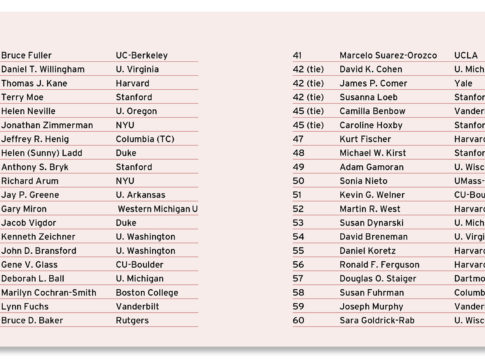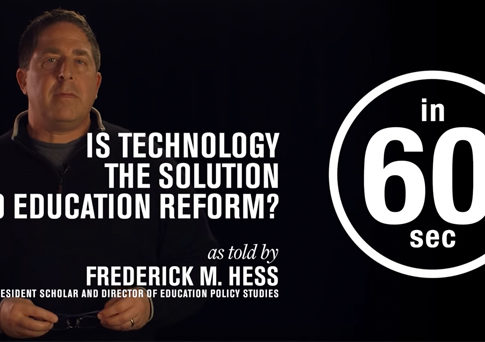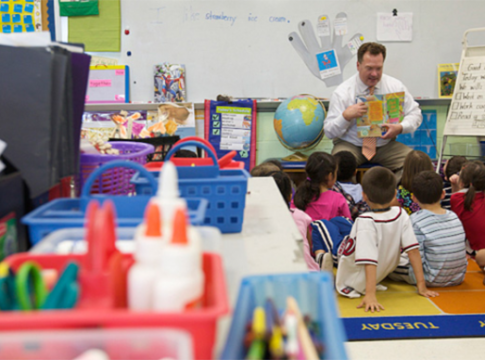Today’s education technology holds immense promise, but what matters more than the tools themselves are how they are used in schools and in classrooms. In Breakthrough Leadership in the Digital Age, Frederick M. Hess and Bror Saxberg argue that educators have tended to think of adopting technology as a way to “reform” or “fix” schools. The would-be reformers have poured tablets and online learning software into classrooms, presuming that magic would eventually happen. But schools are complex and hard to move, while these efforts have been correspondingly unfocused. The more promising way forward involves tapping learning science to determine where the familiar schoolhouse falls short on providing deliberate practice, timely and copious feedback, and extensive opportunities to build mastery—and how new tools can help us do better. Following are three excerpts from the book that convey the core of their argument.
Why educators should start thinking like learning engineers.
 Engineers are the world’s most creative and effective problem solvers. That’s because they combine imaginative thinking with an appreciation for how the world really works. Engineers in any field operate by identifying problems to be solved, designing smart solutions consistent with relevant science, and figuring out how to make those solutions feasible. It’s our contention that education has suffered for its dearth of engineers. In fact, we think, this is why so many of our debates seem to go nowhere. Engineers can bring fresh workable approaches to stubborn problems. As Donald Coduto, civil engineer and professor at California State Polytechnic University, Pomona, once wrote, “Some say the cup is half empty, while others say it is half full. However, in my opinion both are wrong. The real problem is the cup is too big. Sometimes all we need is a new perspective on an old problem.”
Engineers are the world’s most creative and effective problem solvers. That’s because they combine imaginative thinking with an appreciation for how the world really works. Engineers in any field operate by identifying problems to be solved, designing smart solutions consistent with relevant science, and figuring out how to make those solutions feasible. It’s our contention that education has suffered for its dearth of engineers. In fact, we think, this is why so many of our debates seem to go nowhere. Engineers can bring fresh workable approaches to stubborn problems. As Donald Coduto, civil engineer and professor at California State Polytechnic University, Pomona, once wrote, “Some say the cup is half empty, while others say it is half full. However, in my opinion both are wrong. The real problem is the cup is too big. Sometimes all we need is a new perspective on an old problem.”
When it comes to realizing the promise of digital technology, educators need to start approaching classroom challenges as learning engineers. While such a label may sound unfamiliar at first, stick with us for a moment. The fact is that learning engineering is what tech-savvy education leaders—and more than a few who aren’t so tech-savvy—already do every day (whether they know it or not). These educators ask what problems need to be solved for students, turn to research to identify solutions, and devise smarter, better ways to promote terrific teaching and learning. What is education technology’s role in all of this? Learning engineers see this technology as a tool, not a solution.
In fact, just about everything in a school, classroom, or learning environment should be regarded this way. And we mean everything. For example, a team at Kaplan, Inc., an education provider that serves more than a million students a year, was frustrated that classroom furniture was compromising teaching and learning. While classroom furniture isn’t usually regarded as an education technology, it should be. Tables and chairs are tools for learning, just like books, pencils, whiteboards, and laptops. In fact, a 2013 study from England’s University of Salford found that classroom architecture and design factors like classroom orientation, natural light, noise, and use of space had a measurable impact on student learning.
Yet traditional classroom desks and chairs often make it tough for students to collaborate or rotate through activities without wasting time and disrupting instructional flow. In response, Kaplan started piloting new furniture designs from Steelcase, an office furniture company. The new chairs and tables can be easily reconfigured from a lecture-style class setting, to paired or group arrangements, and back again. Kaplan is now collecting data to see how the new configurations are actually working and what modifications are needed. This is learning engineering, applied to furniture.
We’d be surprised if Ford, General Electric, or Apple adopted new technological products without carefully scrutinizing what works, what doesn’t, what’s annoying, and why this is so. Think about how rapidly Internet firms like Amazon or Facebook modify their offerings in response to complaints and feedback. Indeed, designers take care to consider what science and research can teach them about aerodynamic efficiency, convenience, and the rest—and then they try it out, see what happens, try to rapidly fix mistakes, and keep going.
How developments in learning science inform the role of learning engineer.
What we’re talking about is not revolutionary. It’s really nothing more than educators using learning science and technology to solve practical challenges. In a nutshell, that’s what engineers do.
Sure, the familiar caricature of engineers is that they love differential equations and aren’t much fun at parties. The reality is different (well, we make no claims about the parties). Engineers solve real-world problems. Lots of them. Repeatedly and creatively. They do this by taking scientific knowledge, applying it to the problem (whether that involves the strength of steel or the speed of computers), and designing the smartest solution they can find within financial and practical constraints. The best engineers seek optimal solutions that are easy to use well, that serve user needs, and that directly and practically solve the problem at hand. Think of those folks at Apple who cooked up the iPod, the iPhone, and the iPad—imagine if they were immersed in learning instead of semiconductor device science and consumer device usability. They’re what we’ve got in mind.
Unlike scientists, engineers have to account for real-world complications. Ken Koedinger, codirector of the Pittsburgh Science of Learning Center, says of the difference between a scientist and an engineer, “Let me use physics and mechanical engineering as an analogy. Physics comes up with principles. But when engineers have to employ those principles, they have to deal with [practical questions] like the fact that the coefficient of friction depends on the surface that you’re using. Engineering is a different game. Good learning design is not just about principles regarding how learning works, but about learning to apply those principles in a particular context.”
Here’s an easier example: Think of physicians as the engineers of biological science. Biologists explore how cells work, organs function, and molecules interact with each other and with bugs, but it’s physicians who apply this knowledge to solve health problems for real patients. That winds up including asking questions like, “How do I keep this medicine refrigerated in the Serengeti?” Physicians know that what works in a lab is still a long way from working “out there” for a patient—and they pilot, train, and monitor accordingly.
The same is true for learning science and learning engineering. Learning science, for example, teaches that learning has to work through our limited, verbal, conscious minds (“working memory”) before it becomes integrated into our rapid, parallel-processing, nonverbal long-term memory. Moreover, we’ve learned that this is only possible through lots of deliberate practice with targeted feedback. Unfortunately, this science does not reveal how to organize the work of teachers and students to actually do this, so, like any engineer, we still have to apply judgment to the application of the science.
Many factors can contribute to learning difficulties, like awful curricula, mediocre instruction, a lack of timely assessment and student feedback, a lack of discipline, or a student’s inability to find time outside school to do what’s asked. In many of these cases, technology may have a restorative role to play. But technology isn’t always helpful. Indeed, sometimes it can be a distraction. Some readers may recall the early era of desktop publishing, when the earliest Macintosh computers allowed users to select fonts as they liked. Some of us (no names!) created documents festooned with fonts of different kinds, drunk on the opportunity to shift with every paragraph, every page, and every topic. Needless to say, that did not help with the clarity or accessibility of the writing.
Similarly, while we can now view a page from a biochemistry textbook on our iPhone, or even write a term paper on one, this does not mean it’s wise to do so. The question is not what can be done with technology, but what technology can do to promote learning. When a principal bragged to us that a student had written a term paper on his smartphone, we could only wonder whether the principal would have bragged that the student wrote a term paper without using his smartphone. If not (and we presume the answer is “no”), then the principal was fixated on the technology rather than the learning. And that’s a recipe for disappointment.
Case study of the Carpe Diem Collegiate High School and Middle School in Yuma, Arizona, where the idea of thinking like a learning engineer has been put into practice.
Founded in 2002 by Rick Ogston, former president of the Arizona Charter School Association, Carpe Diem explored a “blended” learning model, combining computer-assisted instruction with redesigned classrooms. Carpe Diem offers a radical twist on the familiar schoolhouse: more than 200 personal cubicles, each containing a computer, fill the single room that makes up one floor of the school. Hechinger Report journalist Nick Pandolfo has noted that it “looks more like an office or call center than a school.” Students split their time between individualized online instruction on their personal computers and teacher-led collaborative workshops.
At the heart of the redesign was a desire to help students learn better. As Ogston explains, “Now, the chalkboard model may seem more ‘efficient,’ since you have a lot of people doing the same thing at the same time, but it’s not very good for learning. I was looking to see how we could provide more individualized and personalized instruction for kids. And, at this point in time, the best way to do that is to leverage technology. Now if you can find a better way, great.”
The key, Ogston says, is to understand technology as a tool rather than some kind of secret sauce. He says, “When you’re leveraging technology like we are, people want to look at us in terms of technology. But the secret sauce is not the technology, it’s the relationships. The downstairs is the collaborative social learning environment, and the upstairs looks like a call center. People say this looks impersonal. I say, ‘Well, as opposed to a classroom with rows of desks and a teacher lecturing?’ You know, that doesn’t strike me as real personal, either. The upstairs offers space that’s separate and non-social so that students can focus on their own path and the downstairs is a place for collaboration. That’s the blend that we find works.”
The Carpe Diem design required “the entire ecosystem to change, including the role of teacher, parent, student, and administrator,” Ogston notes. The school has five teachers and four teacher aides for 226 students with each teacher teaching all the students in their subject, regardless of grade level.
So, for instance, Carpe Diem has one math teacher for all students in grades 6–12. It’s not about economy, Ogston explains, but about cultivating relationships that can span across grade levels and reducing the learning curve required for teachers and students to start from scratch each year. Ogston says that teachers get to know their students, their career goals, their family, and their learning needs.
Ogston came to education not as a career educator but after earlier stints in the Marines, business, as a family therapist, and as a church pastor. When he entered schooling, he eventually earned a Master’s in Education and found himself running two charter schools. In that role, Ogston recalls, “Just like I had feared, I realized one day that we had re-created the traditional system.” Ogston’s eclectic background may have helped equip him to think differently about technology and school design. Nearly a decade ago, he sat down with a consultant and a computer to explore what was possible. He remembers, “I didn’t know the terms and all the pedagogy…. I ended up creating the model just by asking questions. Then I put that on the shelf. A year and a half later, the building we were leasing was being sold out from under us and we needed a new home. With this new model, I didn’t need all these individual classrooms, I just needed one large space—a call center would be fine. We found a space and did a conversion in three months.”
Carpe Diem has delivered some promising results, while serving a student population that was 46 percent low-income in 2011–12: Carpe Diem ranks among Arizona’s 10 highest-performing charter schools, outperforming Arizona’s statewide four-year graduation rate five of the six years between 2007 and 2012 (with a 96 percent graduation rate in 2011), and regularly exceeding the Arizona average at every grade level on the statewide assessment.
The Carpe Diem model is also cost-effective. It requires fewer teachers per student than a traditional school, so Carpe Diem has achieved those results with only about $5,300 of the $6,300 per pupil allocation, according to Ryan Hackman, the school’s chief operating officer. Most of the balance goes toward paying off the bond on the $2.6 million facility or to procuring technology (the school sets aside 2.5 percent of its budget, or about $50,000 a year, for this purpose) [see N. Pandolfo, “Education Nation,” The Hechinger Report, 2012]. Ogston says of the model, “One of the wonderful benefits of what we do is that it becomes more economical, even though it wasn’t designed with that in mind. Now, teacher unions are making accusations that computers will replace the teachers. My usual retort is, ‘If a computer can replace you, then it probably should.’ They tend to just gasp and stare at me. And I go on to explain that a really good teacher could never be replaced by a computer. And so, if you think you could be, then, maybe you should evaluate what kind of a teacher you are.”
Ogston notes there are plenty of stumbling blocks and pitfalls for learning engineers. He wryly acknowledges, “I’ve been stupid. When I started this, I didn’t know anything. And I didn’t know what I didn’t know.” And, he says, “I think we’re still like 10 years behind where we should be. But technology and financial limitations tend to impinge upon my happy exploration.”
For others pursuing tech-enabled redesign, he advises: “The most important thing is the vision of what it is you’re going to do. Do your research on technology. Are you simply trying to overlay the technology over the existing system? Or is it a transformational initiative to truly personalize education? Once you’ve got a vision, there are various kinds of support that are needed in terms of curriculum and infrastructure. Trying to backfill technology into existing systems can be difficult.”
Radical? We suppose. But what we find most interesting is that in using technology to rethink the schoolhouse, Carpe Diem has focused on the latter, not the former.
Frederick M. Hess is director of education policy studies at American Enterprise Institute and executive editor at Education Next. Bror Saxberg is chief learning officer at Kaplan, Inc.
This article appeared in the Spring 2014 issue of Education Next. Suggested citation format:
Hess, F.M., and Saxberg, B. (2014). Schooling Rebooted: Turning educators into learning engineers. Education Next, 14(2), 46-50.





